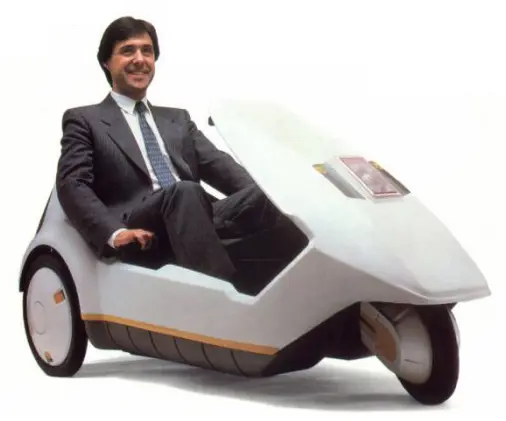THE SINCLAIR C5 REMEMBERED
23 September 2021

For many years, the Sinclair C5 has been regarded as a joke along with Sigue Sigue Sputnik records and The Roxy on ITV. It deserves a better fate, not least because it represented a new form of motoring, an electrically powered tricycle that anyone aged over 14 could drive on the road sans tax, licence or insurance.
The Sinclair electric vehicle project dated back to 1979. In August of 1983, new government legislation permitting electrically assisted two and three-wheelers on the highway shaped the C5’s eventual form. The maximum speed of such vehicles was restricted to 15 mph and their weight to no more than 60kgs. In addition, their motor’s output could not exceed 250 Watts.
Sales of the C5 commenced on the 10th January 1985, with displays in electricity board showrooms. The introductory price was £399, rising to £428 if it was delivered by mail. However, should the owner specify such extras as wing mirrors, a horn, or a spare battery, the cost would be more than £600. You could also order your C5 with an optional ‘high-visibility mast’.
The specification included a (very small) boot and weather protection via side fabric panels and, best of all, a special anorak. Steering was by handlebars under the rider’s legs, and pedals augmented the electrically powered motor. The owner could recharge it via a standard domestic socket overnight and obtain spares via their nearest Hoover outlet.
One marketing challenge was that the C5 did look extremely vulnerable in traffic. Nor did the user require any training or a crash helmet but a Department of Transport official informed the press: “When considered as an alternative to pedal cycles, it is not thought likely to have a worse safety record, though if large numbers are to be used on the roads, it is accepted that they will be involved in accidents, and their record will be closely monitored.”
The late Sir Clive Sinclair predicted sales of 100,000 in the first year, believing “It’s ideal for shopping, going to the office, going to school, any trip around town”. The C5 certainly was a remarkable machine, with a shell made of polypropylene and mounted on a spinal steel chassis. A Ferranti microchip monitored its operation; an electric fan motor drove the single speed, belt-driven transmission, and even the wheels were made from glass-reinforced nylon.
Naturally, the BBC despatched William Woollard to evaluate the C5 for Top Gear. He regarded it as a ‘fun vehicle’ https://www.facebook.com/watch/?v=210357610073468 although the great man was unable to place his foot on the front bumper, largely because the Sinclair lacked one. Meanwhile, Stirling Moss believed that the owner should regard it as a bicycle; “If people get into it and in any way think that they’re in a car because they’re sitting down, then they’re in trouble”.
Riders soon discovered that the C5’s motor often cut out when negotiating a hill and that the battery’s range was somewhat less than the claimed twenty miles. The Merthyr Tydfil factory made a mere 14,000 units, and when production ceased in late 1985, only 5,000 of these found a customer.
Yet, given the proliferation of electric scooters thirty-six years later, it could be argued that the C5’s main problem was that it really was decades before its time. And so, as a tribute to this much-maligned vehicle, here is the original TV commercial promising ‘a new power in personal transport’: https://www.youtube.com/watch?v=0EQetm_qWDg.
